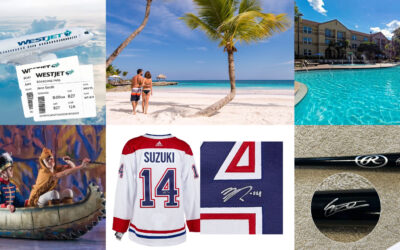Federated Health Charities’ mission is to improve the health and quality of life of all Ontarians by supporting 21 different health charities providing critical services to those experiencing, or affected by, illness. We believe education and prevention are key parts of supporting the health of our communities so our weekly Health Hint series strives to provide tangible and easy to implement hints and tips on how to maintain your health, prevent disease, and enjoy increased quality of life. Check out our latest Health Hint on allergies. We hope you find it helpful. If you would like to join our efforts to support the health of Ontario please consider a donation to Federated Health Charities.
An allergy is an adverse or inappropriate response of one’s immune system to certain foods, inhalants, or chemicals that could be entirely harmless for many others. Most commonly an allergic reaction can cause headache or fatigue and may include itching, sneezing watery eyes, and nasal congestion, however, most severe reactions are called anaphylactic and are characterized by swelling of tissues and impaired breathing (Galland & Galland, 2017).
Types of allergies:
Type 1:
Most common reactions result from the formation of an antibody called immunoglobulin E (IgE). As IgE attaches to an allergen (type of an antigen that may cause a noticeable response), mast cells are stimulated to release mediators like histamine which can cause an allergic reaction from allergy triggers such as pollen, mold, and certain foods etc (Psenka, 2015).
Type 1 allergic reaction occurs with anaphylaxis, eczema, hives, hay fever, and allergic asthma. Symptoms that are caused by the release of histamine from mast cells are “early phase” allergic response, while “late phase” responses occurs 2-6 hrs after exposure to an allergen and are characterized by swelling and redness due to the arrival of other inflammatory cells (eosinophils, neutrophils, and lymphocytes etc.) to the area. These reactions may last for days and can cause long-lasting changes in tissues or the immune system, damaged tissues healed with scarring and in the immune system, lymphocytes may increase production of IgE antibodies, which may enhance allergy phenomena (Braly & Holford, 2008).
Type 2 and Type 3:
These types depend upon another class of antibodies called IgG (immunoglobulin G), to intensify the allergic reaction. IgG is the main type of antibody circulating in the blood and its deficiency can lead to recurrent and chronic bacterial infections (Vickerstaff, 2003).
Type 2 & 3 reactions are mainly involved with drug allergies and may occur in very few food allergies and symptoms could be migraine headache, abdominal pain and arthritis. The onset of allergic reaction is often delayed and sometimes it is 24 hrs or more after exposure to an allergen (Psenka, 2015).
Type 4:
These are also known as delayed hypersensitivity reactions and do not need antibodies, the triggering antigen can directly activate immune cells, called helper lymphocytes which magnify the response themselves (Galland & Galland, 2017).
Type 4 reactions occur in many infectious diseases, such as tuberculosis where they help to control the spread of infection. They also contribute to the damage that occurs in several autoimmune disorders such as rheumatoid arthritis, Crohn’s disease, type 1 diabetes, multiple sclerosis, and Hashimoto’s thyroiditis. The most common allergic disorder with type 4 mechanism is poison ivy, an allergic skin rash caused by exposure to oil of specific plants (genus Toxicodendron) (Galland & Galland, 2017).
Allergy Test:
A skin prick test is usually done to identify allergies to pollen, mold, pet dander, dust, mites and foods. It is a check for immediate allergic reactions (Nadeau & Barnett, 2020).
Role of different foods to initiate an allergic reaction:
The food allergy rate has globally increased over the past few decades and continues to do so, up to 8 percent of children and 11 percent of adults worldwide have a food allergy. (Nadeau & Barnett, 2020).
Points to mention:
- Food intolerance is not a food allergy
- Food/chemical sensitivity is not a food allergy
- Food poisoning is not a food allergy
- Nutritional deficiency is not a food allergy
Many digestive symptoms are linked to food allergies such as inflammatory bowel syndrome and Irritable bowel syndrome (IBS) (Nadeau & Barnett, 2020).
Top 20 common delayed onset igG food allergies:
- Cow’s milk-especially nonfat and low-fat milk
- Gluten grains- found in wheat, rye, barley, oats, kamut, spelt, and triticale
- Gluten- found in wheat, rye, and barley
- Yeast
- Egg white- children mostly affected
- Cashew nut
- Egg Yolk- Adults are commonly affected
- Garlic
- Soybeans
- Brazil nuts
- Almonds
- Corn
- Hazelnuts
- Oats
- Lentils
- Kiwi fruit
- Chili pepper
- Sesame seeds
- Sunflower seeds
- Peanuts-one of the most frequently cited causes of life-threatening anaphylactic reaction, botanically unrelated to nuts.
Action Plan:
What to do to minimize allergic potential and swiftly become allergic-free?
- Eliminate food allergens, read labels carefully.
- Follow a strict three or four-day rotation diet.
- Minimize wheat and milk products even if you are not allergic.
- Eat a fresh salad every day or at least three portions of vegetables.
- Eat two to three pieces of fruit daily.
- Try to consume at least 10 mg of quercetin every day from tea and foods such as red onions, apples, and berries.
- Eat fish, (unfried and unbreaded) which is rich in omega-3 fats.
- Have ground flax seeds and pumpkin seeds, and use flaxseed oil and extra virgin olive oil in salad dressings.
- Drink eight glasses of water or herbal tea every day, avoid fruit juices and other sweetened drinks.
Importance of nutrients to combat allergy:
The deficiency of several nutrients affects immune functioning and later may link to allergy development. Deficiency of vitamin D can contribute to the onset and severity of asthma, the development of food allergies, eczema, nasal allergies, and allergies in general. Zinc and Selenium levels have also been found to be low in some people with asthma and eczema.
Magnesium and vitamin E deficiency is related to a high risk of asthma and allergic sensitization. A higher level of vitamin C is associated with decreased risk of asthma in childhood, similarly, decreased level in blood is associated with asthma in adults. Essential Fat: a higher level of Omega 3 is linked with a lower risk of asthma in youth, however, it also improves the immune system (Nadeau & Barnett, 2020).
What to do?
If someone experiences an allergic reaction and wants to recover as quickly as possible,
- Stop eating foods that trigger an allergic reaction.
- Drink only filtered water and drink plenty of it, at least 10 glasses of water a day, (a measure that you are drinking enough is that you will have to urinate frequently, and that urine will be clear in color.
- Some health professionals suggest large therapeutic doses of vitamin C. It may lead to diarrhea which in turn will reduce allergic symptoms (Nadeau & Barnett, 2020).
- When the allergies are gone you begin eating again, be extremely careful to avoid all the foods you were eating three days before the onset of an allergic reaction, and try eating much smaller portions of all foods for several days, chew it properly before swallowing.
We hope you enjoyed our latest Health Hint!
Written by Nadia Mumtaz
Bibliography
Braly, J., & Holford, P. (2008). Hidden Food Allergies: The essential guide to uncovering hidden food allergies– and achieving permanent relief. Basic Health Publications.
Galland, L., & Galland, J. (2017). The allergy solution: Unlock the surprising, Hidden Truth about why you are sick and how to get well. Hay House.
Nadeau, K., & Barnett, S. (2020). The end of Food Allergy: The first program to prevent and reverse a 21st-century epidemic. Avery, an imprint of Penguin Random House.
Psenka, J. (2015). Dr. Psenka’s seasonal allergy solution: The all-natural 4-week plan to eliminate the underlying cause of allergies and live symptom-free. Rodale.
Vickerstaff, J. J. M. (2003). Dealing with food allergies: A practical guide to detecting culprit foods and eating a healthy, enjoyable diet. Bull.






